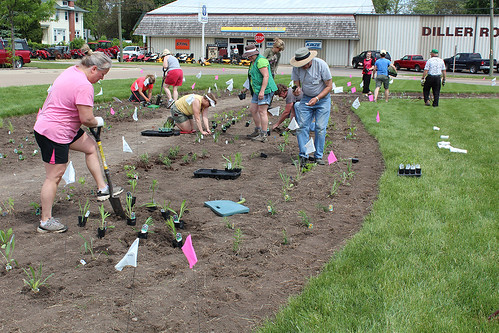
What’s the buzz going on in Princeton, Ill.? A food fest for our pollinator friends, that’s what.
This is a People’s Garden designed specifically for pollinators such as bees, butterflies and hummingbirds. The idea came to Ellen Starr, area biologist with the USDA’s Natural Resources Conservation Service, while walking her dog one day.
“Populations of many pollinators are in serious decline,” said Starr, a fan of pollinators. “So what better way to educate the public about the issue than create a garden?”
The People’s Garden Initiative began in 2009 in honor of President Lincoln’s founding of USDA as the “People’s Department” with a challenge to employees to create gardens at facilities worldwide.
In keeping with the mission of the People’s Garden Initiative, the garden planted last month will benefit the community, be a collaborative effort and incorporate sustainable practices.
It took several months to find a location, but finally the garden found a spot in front of the public library. Perry Memorial Hospital owns the land and was very glad to welcome the garden to their green space, Starr said.
“The library can use the garden for educational sessions,” Starr said. “I am giving two talks this summer about gardening with native plants and the importance of pollinators. Both talks were prompted by the planting of this garden.”

Gardens, especially ones with native plants, provide food and habitat for pollinators. This 2,400-square-foot garden has 710 plants, comprised of 28 different native species.
Some of the native plants include wild geranium, butterfly weed, goldenrod and New England aster and will bloom throughout early spring to late fall.
“All the plants have nectar high in sugar and will be a great source of food for the pollinators,” Starr said, noting the benefits of native plants for food and sanctuary for pollinators.
A path made of stone runs through the middle of the garden making it easier for those who are curious to get a closer look. Signs were placed throughout the garden to identify the plant species.
Late last month, volunteers consisting of Master Gardener members, USDA employees and others who just like to garden helped establish the People’s Garden. Within a few hours the ground came to life.
Each year the plants grow, they will fill in and slow weed growth.
“We hope the community will stop by often to see the changes as the plants grow and learn what they can do in their own yard and help pull a few weeds too,” Starr said.
Some of the garden’s partners include Princeton Graphics, Bureau County Pheasants Forever Chapter, Xerces Society for Invertebrate Conservation, Friends of the Garden and local businesses.
This week, USDA is celebrating National Pollinator Week by highlighting the many ways in which conservation benefits pollinators.

